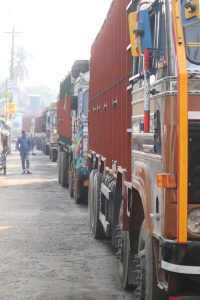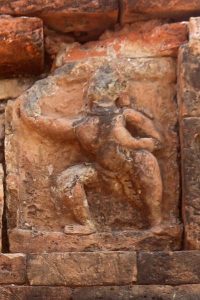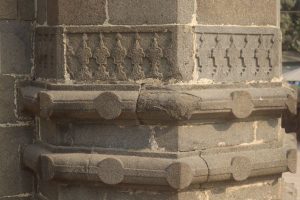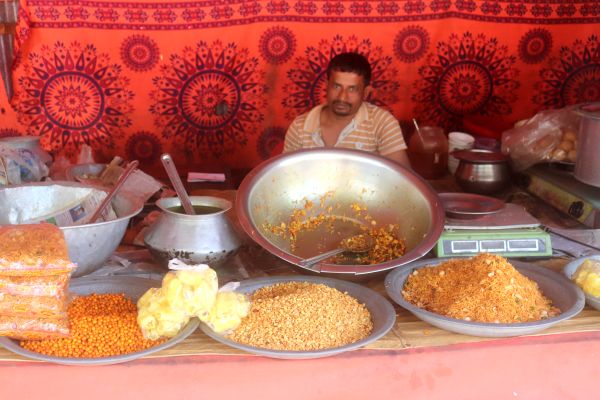There are a few major historical sites in this part of Bangladesh, and we drive from Saidpur to Rajshahi to visit some, covering a range of religions in the process.

a proud local tuktuk driver who has dyed his hair and beard orange, popular here in the belief that the prophet had orange hair
But first we stop at another border crossing with India, at the town of Hili. Luckily on the way, so that it doesn’t take a lot of extra driving. Borders are a thing, with this group, and this one is, at least, actively working. A whole line of empty Indian trucks is waiting to cross back into India. One customs official is specifically perched high on a kind of tennis umpire chair, from where he can look into the open trucks to check if they are really empty. We watch the border for a while, and then continue. T-shirts, anybody?
The Pahapur temple
The most impressive religious site, by far, is the old Buddhist complex Paharpur, the most important known Buddhist structure south of the Himalayas. It was built by one Dharmapala, the 2nd emperor of the Pala dynasty, at the end of the 8th Century AD and was called Somapura Mahavihari, or Great Monastery. But from the end of the 9th C the Pala empire suffered repeated attacks from outside, the monastery was burnt down, and by the 12th C the monastery was gradually abandoned for lack of patronage in an increasingly Hindu-dominated environment.
During the following centuries the building was slowly covered by sand, forming a hill in the landscape that protected the remains, until in 1923 serious excavations were started, yielding a great archaeological treasure, and unearthing what was left of the structures. Which is what we see today, enhanced by further restorations, especially of some of the decorations surrounding the main temple.
The Kusumba mosque
One of the oldest mosques in Bangladesh is the Kusumba Masjid, a 16th C mosque from the time the Mughuls dominated India – although the ones who ordered the construction of the mosque were the Aghan rulers that controlled Bengal at the time. It is built from grey stone, and the outer sides are beautifully worked, with decorations that occasionally also do resemble Hindu symbols. The inside has some brick vaults, and no less than four exquisitely carved stone mirhabs, with mostly nature motifs.
The Puthia comples
Nearer to Rajshani we visit the extensive temple complex and zamindar palace in Puthia. The first building is the palace itself, the Puthia Rajbari, built in 1895. It is a rather opulent building, with a loggia and huge Dorian pillars at the front, and metal decoration along the edges of the veranda. Currently, it is used as a museum, but in the past it was occupied by the district administration.
The Puthia dynasty stems from the 15th C, and has been ruling the area until the zamindar system was abolished under Pakistani law in 1950. Many of the rulers were women, and many contributed significantly to public life, amongst others by building numerous temples around the complex. One such is the Bara Govinda temple, a fabulous brick building, beautifully decorated at the outside. Delicate terracotta carvings with battle scenes and other Hindu tales can be found above the entrances. A smaller temple, the Bara Anhik Mandir (large Ahnik temple) is somehow chucked away behind the palace, its front squeezed next to another building, what makes appreciation more difficult. But the decorations are equally, if not more delicate than those of the Bara Govinda.
Across the lawn from the palace is the early 19th C Dol Mancha, a four-storied square building with porches surrounding each floor. A short walk away is the Bara Shiva temple, dating from 1823, which is described as the most outstanding building, but in my view is a bit more basic than the others. There is none of the brick decoration, and the decoration of the arches looks more the result of stucco. Besides the Shiva temple is another small temple, the octagonally shaped Jagannath temple.
There are several other temples around, but time, as always, is limited – the disadvantage of group travel -, so we make our way to Rajshahi.















































